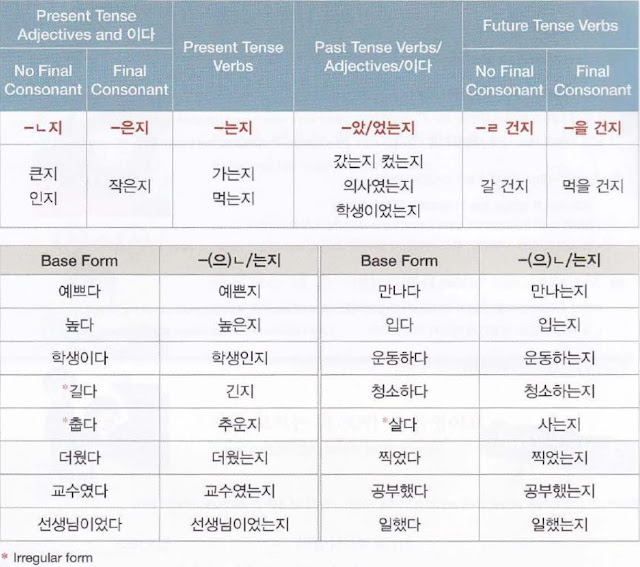 명동에 어떻게 가는지 알아요?
명동에 어떻게 가는지 알아요?
Do you know how to get to Myeongdong?
저 분이 누구인지 모르겠어요.
I don’t know who that person is.
어제 무엇을 했는지 생각이 안 나요.
I can’t remember what I did yesterday.
Grammar Focus:
-(으)ㄴ/는지 is a connective ending used when connecting a clause requiring additional information to the following verb. It corresponds to ‘who/what/where/when/how/whether + Clause’ in English. It generally precedes one of the following verbs: 알다 (to know), 모르다 (not to know, be unaware of), 궁금하다 (to be anxious or curious about), 질문하다 (to ask a question, to inquire), 조사하다 (to investigate), 알아보다 (to look into, to recognize), 생각나다 (to recall, to remember), 말하다 (to speak, to say), and 가르치다 (to teach).
• 내일 날씨가 좋아요, 나빠요? + 알아요?
Will tomorrow’s weather be good or bad? + Do you know?
->내일 날씨가 좋은지 나쁜지 알아요?
Do you know whether tomorrow’s weather will be good or bad?
• 명동에 어떻게 가요? + 가르쳐 주세요.
How do you get to Myeongdong? + Please tell me.
->명동에 어떻게 가는지 가르쳐 주세요.
Please tell me how to get to Myeongdong.
For present tense adjectives, when the stem ends in a vowel or ㄹ, -ㄴ지 is added, and when it ends in a consonant. -은지 is added. For present tense verbs, -는지 is added to the stem. For past tense adjectives and verbs, -았/었는지 is added while for future tense verbs, -(으)ㄹ 건지 is added.
 Conversation:
Conversation:
A: 제이슨 씨가 병원에 입원했어요. 어디가 아픈지 알아요?
Jason is in the hospital. Do you know what’s wrong?
B: 글쎄요. 저도 어디가 아픈지 모르겠어요.
Hmm. No, I don’t know what’s wrong.
A: 여보, 우리 아들이 지금 공부하고 있어요?
Dear, is our son studying now?
B: 방에 있는데 공부하는지 자는지 잘 모르겠어요.
He’s in his room, but I don’t know if he’s studying or sleeping.
A: 이거 제가 만들었어요. 드셔 보세요.
I made this. Please take a bite.
B: 와, 맛있어요. 이거 어떻게 만들었는지 가르쳐 주세요.
Wow, this is delicious. Please tell me how you made it:
Notes:
-는지 is used in the following forms.
1. Interrogative + Verb-(으)ㄴ /는지
• 우리 아이가 방에서 무엇을 하는지 모르겠어요.
I don’t know what our son/daughter is doing in his/her room.
• 그 사람이 어느 나라 사람인지 알아요?
Do you know what country that person is from?
2. Verb 1-(으)ㄴ/는지 Verb 2-(으)ㄴ/는지
• 우리 아이가 방에서 자는지 공부하는지 모르겠어요.
I don’t know if our son/daughter is sleeping or studying in his/her room.
• 그 사람이 일본 사람인지 중국 사람인지 알아요?
Do you know if that person is Japanese or Chinese?
3. Verb 1 -(으)ㄴ/는지 안 Verb 1-(으)ㄴ/는지
• 우리 아이가 공부를 하는지 안 하는지 모르겠어요.
I don’t know if our son/daughter is studying (or not).
• 그 사람이 일본 사람인지 아닌지 모르겠어요.
I don’t know whether that person is Japanese (or not).
